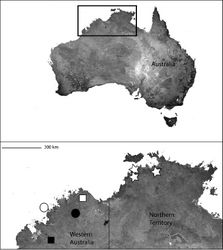Karaops dawara
| Notice: | This page is derived from the original publication listed below, whose author(s) should always be credited. Further contributors may edit and improve the content of this page and, consequently, need to be credited as well (see page history). Any assessment of factual correctness requires a careful review of the original article as well as of subsequent contributions.
If you are uncertain whether your planned contribution is correct or not, we suggest that you use the associated discussion page instead of editing the page directly. This page should be cited as follows (rationale):
Citation formats to copy and paste
BibTeX: @article{Crews2011ZooKeys99, RIS/ Endnote: TY - JOUR Wikipedia/ Citizendium: <ref name="Crews2011ZooKeys99">{{Citation See also the citation download page at the journal. |
Ordo: Araneae
Familia: Selenopidae
Genus: Karaops
Name
Karaops dawara Crews & Harvey, 2011 sp. n. – Wikispecies link – ZooBank link – Pensoft Profile
Type material
Holotype female (WAM T54998): Kakadu National Park, Kapalga, primary site E, 12°36'S, 132°25'E, Northern Territory, Australia, 9.XI.1990, A. Andersen et al.
Other material examined
AUSTRALIA: Northern Territory: Darwin: Charles Darwin National Park, first left hand road after gate, 12°26'12.2"S, 130°52'36.5"E, 15–16.I.2009, S.C. Crews, G. Brown, with egg-sac, on Pandanus, 1♀ (WAM T97225); Litchfield National Park, off Litchfield Road, on road on left side, heading south, 13°03.024'S, 130°51.300'E, 20.I.2009, S.C. Crews, G. Brown, under bark near ‘A2’ sign along road, 1 immature (WAM T97233).
Etymology
The specific epithet comes from the word for spider, dawara, in the indigenous Larrakia language.
Diagnosis
This species can be distinguished from all others by having an abdominal pattern of light spots on a dark background, and by the copulatory organs, as the lateral lobes come into contact for nearly half of the length of the epigynal plate, and the copulatory ducts are long, laterally positioned, and lead to a mass of winding ducts (Figs 79–80). Males unknown.
Description
Holotype:Color: carapace yellow-brown, with slightly darker marks medially; sternum pale yellow-brown; chelicerae pale yellow with darker infuscations anteriorly; maxillae pale yellow-brown; labium pale brown; abdomen dorsally dark grey, with pale patches anteriorly, dorsally and posteriorly; ventrally pale yellow-brown; legs with all segments clearly annulated. Cephalothorax:setae long and thin; 0.83 times longer than broad; fovea longitudinal, broad, very shallow. Eyes:AER nearly straight; PER slightly recurved; PME larger than AME, PLE largest, ALE smallest; eye group width 1.51; eye diameters, AME 0.17, ALE 0.09, PME 0.19, PLE 0.25; interdistances AME-ALE 0.28, PME-PLE 0.26, ALE-PLE 0.23, AME-PME 0.07; ocular quadrangle AME-AME 0.47, PME-PME 0.96; clypeus 0.18 high. Mouthparts: chelicerae with a few stout setae medially and anteriorly; lateral boss present, smooth; promargin with 4 teeth, retromargin with 3 teeth; maxillae longer than broad, with tuft of conspicuous setae distally; labium distally rounded. Sternum:0.85 times longer than broad, posteriorly indented. Pedipalp:tarsus slightly swollen, claw present, with c. 6 teeth. Legs:leg I only slightly shorter than legs II, III and IV; leg formula 2341; scopulae absent on all legs; tarsus I–IV with strong claw tufts; claws without teeth; spination: leg I, Fm pr 1–1–0, d 1–1–1, rl 0; Ti d 0, v 2–2–2–2–2; Mt v 2–2–2–2; Ti and Mt I and II with strong spines; leg II, Fm pr 0, d 1–1–1, rl 0; Ti v 2–2–2–2–2; Mt v 2–2–2–2; leg III, Fm pr 0, d 1–1–1, rl 0; Ti v 1–1–0; Mt 0; leg IV, Fm pr 0, d 1–1–1, rl 1–0–0; Ti pr 1–1–0, v 0, rl 1–0–0; Mt 0. Abdomen:terminal setal tufts present. Epigyne:lateral lobes that come into contact medially, forming a v-shaped opening, sinuate unsclerotized area in the upper third of plate, copulatory openings located laterally in this area; internally, long unsclerotized ducts lead away from the copulatory openings, at the lateral margins, curving medially to a mass of sclerotized coiled ducts, mostly symmetrical, leading to tiny ovoid to round spermathecae, fertilization ducts located posteriorly, posterodorsal fold absent (Figs 79–80). Dimensions: Total length 6.35. Cephalothorax length 2.31, width 2.78. Sternum length 1.26, width 1.48. Abdomen length 3.73, width 3.24. Pedipalp: Fm 0.67, Pt 0.44, Ti 0.58, Ta 0.66, (total) 2.35. Leg I: Fm 2.55, Pt 1.04, Ti 2.31, Mt 1.81, Ta 1.04, (total) 8.75. Leg II: Fm 3.14, Pt 1.14, Ti 5.20, Mt 2.15, Ta 1.01, (total) 12.73. Leg III: Fm 3.44, Pt 1.10, Ti 2.70, Mt 2.27, Ta 1.10, (total) 10.61. Leg IV: Fm 3.24, Pt 0.94, Ti 2.48, Mt 2.27, Ta 1.08, (total) 10.01.
Natural history
This species has been found on Pandanus, under the fronds where they attach to the trunk, as well as under the leaves, and under bark of a log on the ground (Fig. 102).
Distribution
Known only from the northern region of the Northern Territory (Fig. 102; Map 5).
Original Description
- Crews, S; Harvey, M; 2011: The spider family Selenopidae (Arachnida, Araneae) in Australasia and the Oriental Region ZooKeys, 99: 1-104. doi
Images
|


